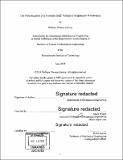The optimization of a Formula SAE vehicle's suspension kinematics
Author(s)
Harvey, William Thomas, S.B. Massachusetts Institute of Technology
DownloadFull printable version (5.688Mb)
Alternative title
optimization of a Formula Society of Automotive Engineers vehicle's suspension kinematics
Other Contributors
Massachusetts Institute of Technology. Department of Mechanical Engineering.
Advisor
Amos Winter.
Terms of use
Metadata
Show full item recordAbstract
The suspension geometry is the foundation of a performance vehicle's design because it dictates the overall packaging constraints and the connection between the chassis and the tires. This thesis details the design process used to produce the suspension geometry for MIT Motorsports' 2018 Formula SAE car and the justification for each design decision made. A thorough iteration process was used to prevent compromises that could significantly detract from specific component performance in order to meet suspension kinematic requirements. Using this process, the kinematic performance of the suspension was maximized by minimizing the roll center's movement and designing the tire camber change characteristics to achieve 0° of outer-wheel camber while at the car's maximum lateral acceleration.
Description
Thesis: S.B., Massachusetts Institute of Technology, Department of Mechanical Engineering, 2018. Cataloged from PDF version of thesis. Includes bibliographical references (page 33).
Date issued
2018Department
Massachusetts Institute of Technology. Department of Mechanical EngineeringPublisher
Massachusetts Institute of Technology
Keywords
Mechanical Engineering.